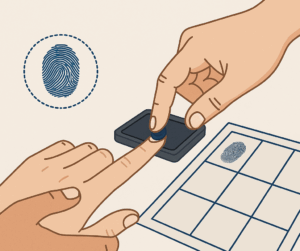Alright, so when most folks hear “fingerprinting,” their brains jump straight to some fancy digital gadget—like those airport gizmos, cop shops, or just unlocking your phone with your thumb. But, surprise surprise, good ol’ Ink & Roll Fingerprinting is still kickin’ around. Yeah, really.
It kinda sounds like something out of an old detective movie. Well, turns out, this messy, inky ritual isn’t just a relic. It’s still a legit requirement for a whole bunch of government stuff—licensing boards, global background checks, the works. You’re after a visa? A pro license? Want to play in the big leagues with federal clearance? Odds are, this inky process is waiting somewhere on your to-do list.
So here’s the deal. I’ll walk you through what the heck Ink & Roll Fingerprinting actually is, why people haven’t given up on it yet, how the whole thing goes down, and where on earth you can get your mitts printed old-school style. Let’s get our hands dirty—figuratively (and maybe literally).
Basics of Ink & Roll Fingerprinting
What Is It
Ink & roll fingerprinting is about getting your fingerprints the OG way—with ink and a card. It goes like this:
– Special ink on your fingers
– Each finger gets rolled (not just pressed) across a government-issued fingerprint card, like the FD-258
– The whole point: to grab all that unique ridge detail
Why “Ink & Roll”?
Not to be confused with just smashing your finger down. Here’s what sets it apart:
– Instead of pressing down flat, they roll your finger nail edge to nail edge
– Rolling = capturing every twist, whorl, and tiny line
– It’s all about accuracy and making sure the print’s actually useful for ID
A Quick History Lesson
Ink fingerprinting isn’t new, not by a long shot:
– Been around since the late 1800s
– Became standard for cops and government everywhere
– Still used today—even though biometric tech is everywhere
Why Stick With It?
Even if it feels kinda old-school, ink & roll has the street cred:
– For more details, see the official FBI guide to fingerprinting.
– Universally recognized
– Holds up in court
– Low-tech, but rock solid
So, yeah—it might not be flashy, but if you need fingerprints that count, ink & roll is still the way to go.

How Ink & Roll Fingerprinting Works (Step-by-Step)
Getting Ready
- You walk in and the tech immediately tells you to wash and dry your hands—no fancy lotions, no oils.
- Seriously, any bit of residue can make a mess of your prints.
Inking Up
- There’s a slab with special fingerprint ink. Not just any ink—this stuff means business.
- The technician grabs your finger and gently, almost like you’re made of glass, rolls it onto the ink.
- Goal here? A nice, even layer—enough coverage, but not a globby mess.
Rolling the Print
- Here’s where the skill kicks in: instead of just pressing your finger flat, the tech rolls it from nail edge to nail edge.
- This trick gets that full fingerprint swirl—not just a smudgy blob.
Print Card Details
- Once the print’s perfect, they press it onto a fingerprint card (FD-258, for the cool kids).
- Your name, date, and personal info get scribbled in.
- Usually, you sign somewhere, too.
- The card needs a minute or two to dry before they send it is sent off.
The Whole Thing—Start to Finish
- Takes 10 to 20 minutes tops.
- Yeah, ink is messier than the digital thing, but it’s sturdy and basically everyone accepts these prints.
- Walk out with ink on your hands and a weird sense of importance.
Honestly, the whole thing takes, what, maybe 10 to 20 minutes? Not exactly a spa day. Sure, it’s a bit messier than just zapping your stuff into a computer, but hey, at least you end up with something tough as nails that pretty much everyone accepts. So, worth that tiny hassle, right?
Why’s Anyone Still Messing With Ink Fingerprinting?
Honestly, with all the fancy tech out there, you’d think we’d have ditched the old ink-and-paper routine ages ago. But nope—good ol’ ink & roll fingerprinting is stubbornly hanging on, and for good reason. It’s kind of like vinyl records: you wonder why people bother, but folks still swear by ’em.
Here’s the deal—
First off, Uncle Sam likes his rules. Government big dogs like the FBI or ATF? They still want those inky prints for certain stuff. No digital funny business—just straight-up ink on a card.
Then you’ve got the international scene. Some countries and embassies look at digital scans and go, “Nah, try again.” They want the real-deal ink prints for things like visas, immigration, or security checks. Old school, but they don’t care.
Professional hoops: If you want to do stuff like nursing, lawyering, selling houses, or making big money moves—chances are, you’re gonna get inked. Licensing boards are kinda obsessed with ink-based background checks.
Trust factor’s wild, too. Ink cards don’t crash, get corrupted, or vanish into the internet void. You can literally stick them in a file cabinet and forget about them until someone in a suit needs to see ‘em in 2042.
If you need a metaphor, think about paper passports. Sure, you might have a fancy digital ID or some facial recognition magic, but when you’re crossing borders? That stamped paper book still rules. Ink fingerprints are basically that—analogue, a little messy, but somehow still king.
Ink & Roll vs Digital Fingerprinting: What’s the Difference?
Both ink and digital methods serve the same purpose—identity verification—but they differ in speed, acceptance, and application.
| Feature | Ink & Roll Fingerprinting | Digital Fingerprinting |
| Process | Ink rolled on paper card. | Electronic scan on a digital pad |
| Speed | 10–20 minutes + drying | Instant |
| Accuracy | Full ridge capture, permanent | Highly accurate but sometimes distorted |
| Acceptance | Global (FBI, ATF, international) | Limited to domestic jurisdictions |
| Convenience | Requires a technician, ink, and cards | Fast, less messy, no ink needed |
Pros of Ink & Roll Fingerprinting
- Pretty much everyone on the planet takes ’em. You need prints for the feds? This is it.
- FBI loves this stuff. Classic. Old-school, but it works, ya know?
- Need to send your prints to another country? Just chuck the card in an envelope and boom—done.
Cons of Ink & Roll Fingerprinting
- Yeah, you’re probably gonna get ink on your hands (and maybe your shirt if you’re clumsy like me). Not exactly glamorous.
- Don’t expect lightning speed—digital is way quicker. Get comfy.
- No, you can’t DIY this at home with a kitchen sponge. Got to see a legit pro to do it right.
Where Can You Get Ink & Roll Fingerprinting Done?
If you need an Ink & Roll service, you have several options:
- Local Police Departments: Many departments still provide fingerprinting services.
- Authorized Fingerprinting Agencies: Certified private providers specialize in both ink and digital prints.
- Mobile Services: Some companies offer mobile fingerprinting, where a technician comes to your home, office, or event.
What to Bring
- A valid government-issued ID (driver’s license, passport, etc.)
- The specific fingerprint card required by the requesting agency (e.g., FD-258)
- Payment (fees vary depending on location and provider)
Tip: Always check the requirements of the agency requesting your prints—wrong formats or poor-quality prints can cause delays.
Common Questions About Ink & Roll Fingerprinting
Q1: Is Ink & Roll Fingerprinting messy?
Not really. The ink is specialized, non-staining, and wipes off easily. Technicians also provide cleaning materials.
Q2: How long does it take?
Most appointments take 15–20 minutes. Results are immediate once the card dries.
Q3: Can I do it at home?
DIY kits exist, but professional technicians ensure accuracy. Poor-quality prints are often rejected by agencies.
Q4: Why not just go digital?
Digital is great for speed, but not all agencies or countries accept it. Ink remains the global standard.
Q5: Which form is commonly used?
The FD-258 card is the most widely recognized fingerprint card, used for FBI and ATF applications.
Final Thoughts: Do You Need Ink & Roll Fingerprinting?
Ink & Roll Fingerprinting might sound outdated, but it’s far from obsolete. In fact, it remains the gold standard for background checks, federal applications, licensing, and international requirements.
If you’re applying for a professional license, immigration visa, or federal clearance, chances are you’ll need ink-based prints at some point.
While digital fingerprinting is convenient, Ink & Roll is still the most trusted, universally recognized, and compliance-ready option.
So the next time someone asks, “Why use ink in 2025?”, you’ll know the answer: because sometimes, the traditional way is still the best.
